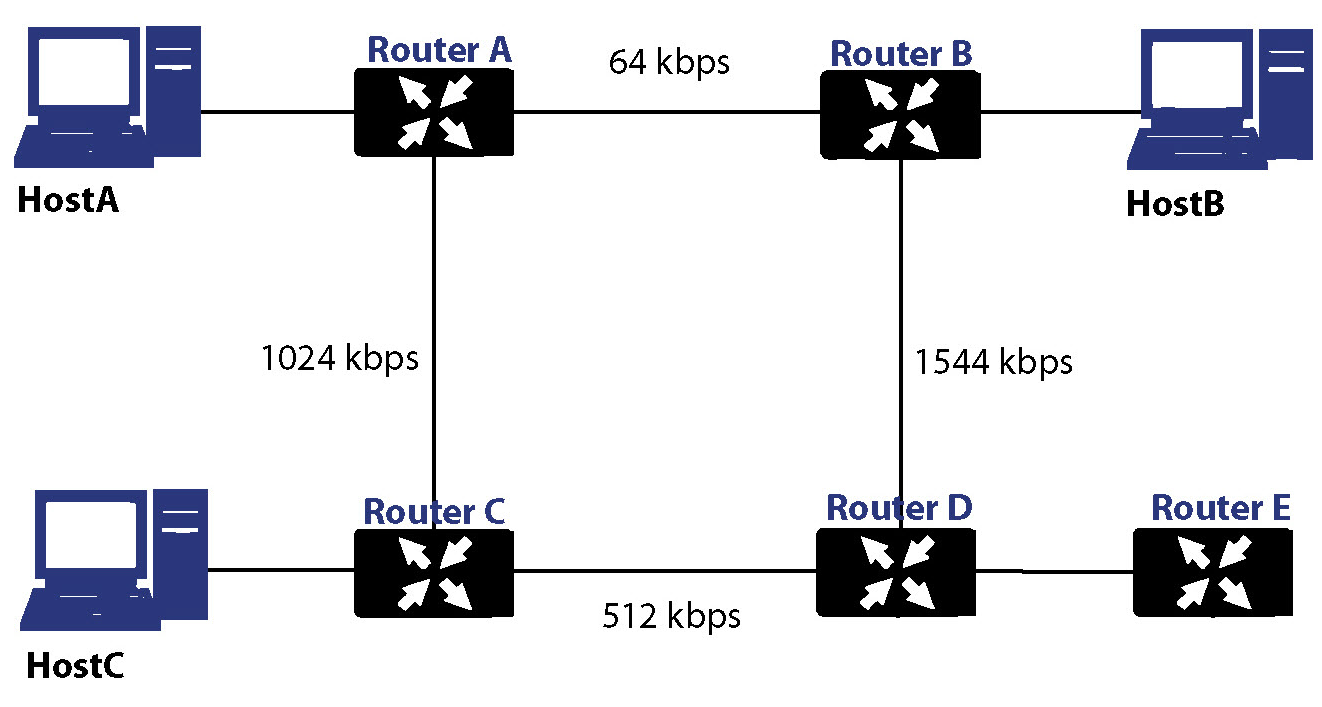
|
Full table broadcast or multicast periodically, slower convergence |
Link state advertisement multicasts, triggered by changes, fast convergence |
||
|
•
|
Protocol Metrics – Distance Vector protocols such as RIP base routing metrics exclusively on hop counts, while Link state protocols such as OSPF consider the state of the link when determining metrics. For example, OSPF determines interface metrics by dividing its reference bandwidth (100mbits by default) by the interface speed – the faster the link, the lower the cost and the more preferable the path. Consider the following example network:
|
|
•
|
Maximum Hops – RIP imposes a hop count of 15 to help prevent routing loops which can occur when bad (for example, stale) routing information is broadcast and propagated through a network either due to misconfiguration, or slow convergence. Consider if the link between Router D and Router E failed in the diagram above, and there were no safeguards in place:
|
Other measures against this sort of situation are also commonly employed by RIP, including:
|
•
|
Split-Horizon – A preventative mechanism where routing information learned through an interface is not sent back out the same interface. This generally works well on broadcast links, but not on non-broadcast links such as Frame Relay, where a single link can commonly be used to reach two separate autonomous systems.
|
|
•
|
Poison reverse – Also known as route poisoning, an extension of split-horizon where a network is advertised with a metric of 16 (unreachable), helping to ensure that incorrect alternative routes aren’t propagated.
|
|
•
|
Routing table updates – As mentioned above, the practice of sending an entire routing table introduces the problems of slower convergences, higher bandwidth utilization, and increased potential for stale routing information. RIPv1 broadcasts its entire routing table at a prescribed interval (usually every 30 seconds), RIPv2 can either broadcast or multicast, and OSPF multicasts only link state updates whenever a change to the network fabric occurs. OSPF has a further advantage of using designated routers (DR) in forming adjacencies in multiple-access networks (more on these concepts later) so that updates do not have to be sent to the entire network.
|
|
•
|
Subnet sizes supported – RIPv1 was first implemented when networks were strictly class A, class B, and class C (and later D and E):
|
|
•
|
Class A – 1.0.0.0 to 126.0.0.0 (0.0.0.0 and 127.0.0.0 are reserved)
|
|
•
|
Class B - 128.0.0.0 to 191.255.0.0
|
|
•
|
Class C – 192.0.0.0 to 223.255.255.0
|
|
•
|
Class D - 225.0.0.0 to 239.255.255.255 (multicast)
|
|
•
|
Class E - 240.0.0.0 to 255.255.255.255 (reserved)
|
VLSM also allows for route aggregation (CIDR):
|
•
|
Autonomous system topologies – An autonomous system (AS) is a collection of routers that are under common administrative control, and that share the same routing characteristics. When a group of autonomous systems share routing information, they are commonly referred to as a confederation of autonomous systems. (RFC1930 and RFC975 address these concepts in much greater detail). In simple terms, an AS is a logical distinction that encompasses physical network elements based on the commonness of their configurations.
|